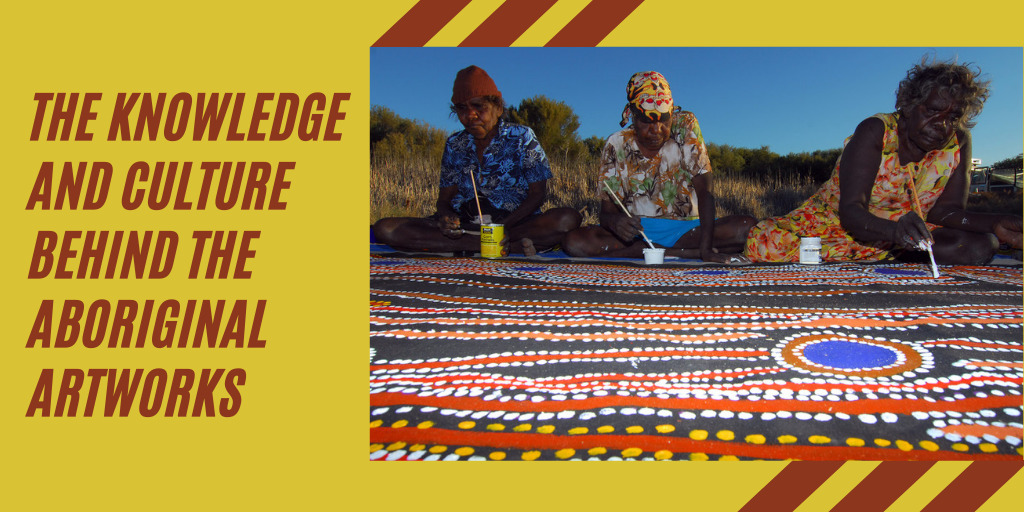NAIDOC Week celebrations are held in July each year however this year’s events were postponed due to the coronavirus pandemic and are now being held from the 8th to 15th of November. Each year, a theme is chosen to reflect the important issues and events for NAIDOC Week (NAIDOC, 2020). The focus for this year is “Always Was, Always Will Be” to recognise that First Nations people have occupied and cared for this continent for over 65,000 years (NAIDOC, 2020). There is no written language for Australian Aboriginal People, rather, important cultural stories and messages have been passed through generations using artwork and symbols (Artlandish, 2020). Aboriginal artwork is one way to explore the connection to Country and the length of occupation of Australia.

Art, Culture and Connection
Culture refers to the values, customs and social behaviour which shape a person’s way of life (Australians Together, 2020). Culture is passed down from generation to generation. Land, Family, Law, Ceremony and Language are five key interconnected elements of Aboriginal culture and may be influenced by the region, Nation or clan group of a particular area (Australians Together, 2020). Artwork has been used by Aboriginal People to convey important cultural stories through generations to share knowledge of the land, events and beliefs, all of which preserves culture (Artlandish, 2020).
Traditionally symbols and stories have been carved or painted onto rocks or in caves by Aboriginal people and their ancestors. The Aboriginal rock art sites along the Burrup Peninsula in the Pilbara Region of WA have been dated back 50,000 years and present carvings of animals now extinct (McDonald, 2018). Sites where art is present, such as the Burrup Peninsula, hold cultural importance to Aboriginal people today highlighting the importance of art, culture and connection to the land.
Dreamtime
The ‘Dreamtime’ or ‘Dreaming’ is a western word which has been used to describe the unique stories and beliefs held by Aboriginal Groups which explain how the land and life came into being (Japingka, 2020). Ancestral spirits form a significant part of ‘Dreaming’ and remain as a link between past, present and future (Japingka, 2020). Dreamtime stories are an essential part of Aboriginal culture which pass on knowledge, customs, traditions and values (Artlandish, 2020). Dreamtime stories have been shared through music, dance, ceremony and through artwork.

Traditionally art was used by body paint, sand drawings, wood carvings and rock art using natural materials such as ochre and charcoal (Aboriginal Art Association of Australia, 2020). In the Kimberley region of WA the Wandjina ancestral spirit associated with rain features in many Dreaming stories and artworks including rock art which has been dated over 4000 years (Aboriginal Art Association of Australia, 2020). Today Dreamtime stories are painted on canvas or textiles using a mix of traditional and modern mediums. Regardless, the artwork depicts important stories and beliefs relating to Dreaming, preserving culture and history.
Symbolism
Symbols are an integral part of Aboriginal artwork and are used to convey messages and stories. The symbols used may be different between Aboriginal Groups. For instance, the Groups of the Western Desert region utilise a wide range of symbols, often combined together, to present stories. The symbols presented in the figure below are commonly seen in artwork from the Papunya People of the Central Desert region. This shows people as a U shape and key features in the landscape presented by a series of circles and lines (Artlandish, 2020).

Dot paintings are perhaps the most synonymous with Aboriginal art and are recognised and associated internationally with Australia. Traditionally symbols and stories would have been drawn into sand or onto the body and washed away, however, this cannot be done when using acrylic and canvas mediums (Japingka, 2020). The dots used have a deeper purpose and rather than present a story are used by an artist to disguise the sacred meanings behind the stories within the painting and were first used in Aboriginal art in the 1970’s (Artlandish, 2020).
Aboriginal culture and artwork is a major part of the wider Australian culture and history. As non-Aboriginal Australians, it is our responsibility to understand and respect Aboriginal culture. This means not just displaying Aboriginal artwork but understanding the deeper meaning artwork plays in Aboriginal culture.
Integrate Sustainability acknowledge the Traditional Custodians associated with the land on which we are based, the Whadjuk Boodja people, and pays respect to their Elders past, present and emerging. If you or your company requires advice or assistance in identifying and working with an aboriginal group in your area, please call Integrate Sustainability on 08 9468 0338 or email enquiries@integratesustainability.com.au.
References
Aboriginal Art Association of Australia. (2020). Traditional Aboriginal Art. Retrieved from https://www.aboriginalart.com.au/gallery/traditional.html
Artlandish. (2020). The Story of Aboriginal Art. Retrieved from https://www.aboriginal-art-australia.com/aboriginal-art-library/the-story-of-aboriginal-art/
Australians Together. (2020). Why are culture and identity important? Retrieved from https://australianstogether.org.au/discover/indigenous-culture/culture-identity/
Featured Image: Art Supplies, 2018. A Walk Through Time With Aboriginal Art. [Online]. Available at: https://www.artsupplies.co.uk/blog/a-walk-through-time-with-aboriginal-art/ [Accessed November 2020]
Japingka. (2020). Aboriginal Dreamtime Stories. Retrieved from https://japingkaaboriginalart.com/aboriginal-dreamtime-stories/
McDonald, J. (2018). Explainer: why the rock art of murujuga deserves world heritage status. The Conversation. Retrieved from https://theconversation.com/explainer-why-the-rock-art-of-murujuga-deserves-world-heritage-status-102100
NAIDOC. (2020). 2020 Theme. Retrieved from https://www.naidoc.org.au/get-involved/2020-theme

